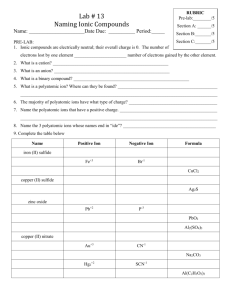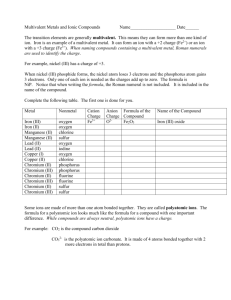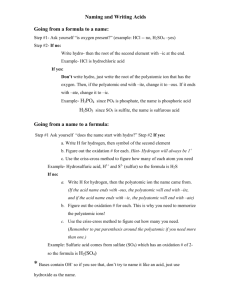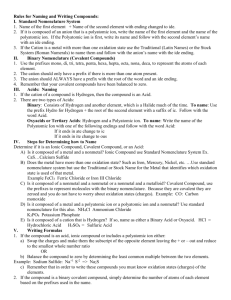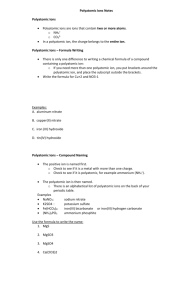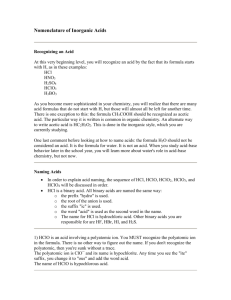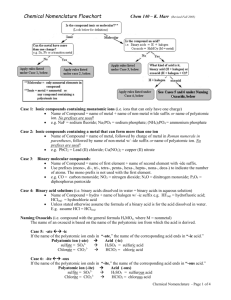Dichotomous Key for Naming
advertisement
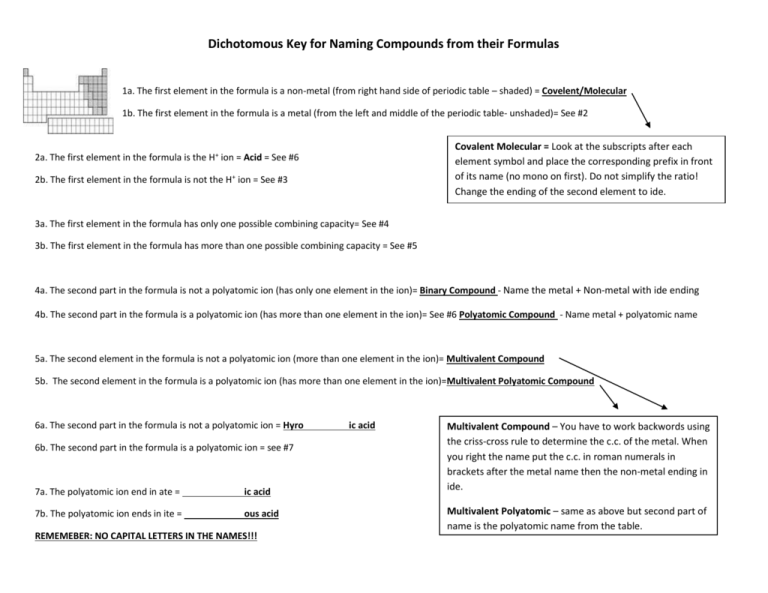
Dichotomous Key for Naming Compounds from their Formulas 1a. The first element in the formula is a non-metal (from right hand side of periodic table – shaded) = Covelent/Molecular 1b. The first element in the formula is a metal (from the left and middle of the periodic table- unshaded)= See #2 Covalent Molecular = Look at the subscripts after each element symbol and place the corresponding prefix in front of its name (no mono on first). Do not simplify the ratio! Change the ending of the second element to ide. 2a. The first element in the formula is the H+ ion = Acid = See #6 2b. The first element in the formula is not the H+ ion = See #3 3a. The first element in the formula has only one possible combining capacity= See #4 3b. The first element in the formula has more than one possible combining capacity = See #5 4a. The second part in the formula is not a polyatomic ion (has only one element in the ion)= Binary Compound - Name the metal + Non-metal with ide ending 4b. The second part in the formula is a polyatomic ion (has more than one element in the ion)= See #6 Polyatomic Compound - Name metal + polyatomic name 5a. The second element in the formula is not a polyatomic ion (more than one element in the ion)= Multivalent Compound 5b. The second element in the formula is a polyatomic ion (has more than one element in the ion)=Multivalent Polyatomic Compound 6a. The second part in the formula is not a polyatomic ion = Hyro 6b. The second part in the formula is a polyatomic ion = see #7 7a. The polyatomic ion end in ate = ic acid 7b. The polyatomic ion ends in ite = ous acid REMEMEBER: NO CAPITAL LETTERS IN THE NAMES!!! ic acid Multivalent Compound – You have to work backwords using the criss-cross rule to determine the c.c. of the metal. When you right the name put the c.c. in roman numerals in brackets after the metal name then the non-metal ending in ide. Multivalent Polyatomic – same as above but second part of name is the polyatomic name from the table. Dichotomous Key for Writing Formulas from their Names 1a. The name has pre-fixes in it = Covelent/Molecular – use the prefixes to determine the subscripts after each element. Do not simplify the ratio! 1b. The name does not have pre-fixes in it = See #2 2a. The name has acid at the end = Acid = See #6 2b. The name does not have acid in it = See #3 3a. There are no roman numerals after the first name= See #4 3b. There are roman numerals after the first name = See #5 Polyatomic Compound = Same as Binary compound but put a bracket around the polyatomic ion if their is a subscript after it!. 4a. The second part of the name ends with ide = Binary Compound – Write down the ions then use the criss-cross rule and simplify the ratio 4b. The second part of the name does not end with ide = See #6 Polyatomic Compound 5a. The second part of the name ends with ide = Multivalent Compound 5b. The second part of the name does not end with ide =Multivalent Polyatomic Compound Multivalent Compound – The roman numeral after the metals name tells you its c.c. Write down the two ions then use the criss-cross rule and simplify the ratio. Multivalent Polyatomic – same as above but second part of the formula is from the polyatomic table. Put a bracket around the polyatomic ion if their is a subscript after it!. 6a. The name starts with hydro = Hyro ic acid = Hydrogen ion with non-metal ion from periodic table. Use criss cross rules and simplify the ratio. 6b. The name does not start with hydro = see #7 7a. The name is in the form ic acid = Hydrogen ion with polyatomic ion ending with ate. Use criss cross rules and simplify the ratio. Put a bracket around the polyatomic ion if their is a subscript after it!. 7b. The polyatomic ion ends in ite = ous acid = Hydrogen ion with polyatomic ion ending with ite. Use criss cross rules and simplify the ratio. Put a bracket around the polyatomic ion if their is a subscript after it!.
